Have you ever considered canning flour? I hadn’t considered it to be honest, until someone brought it up to me the other day. I looked into it, and it makes sense.
First, using flour in our household goes in waves. Some months we are using it several days a week and go through quite a bit of it. Then, we go through a dry spell and it can sit in the cupboard for quite a while. So, I really never know how much to have on hand, because it might not be any good the next time we get into a baking frenzy.
Second, I know I can store it in airtight containers, which will help boost the shelf life. However, airtight containers can be bulky, especially if you have an abundance of flour to store.
Canning it in individual jars that can sit all together on a shelf, or spread them out to fit your space issues, makes a lot of sense for our household. And, it just might for yours as well. Please note that this method provides shelf life for at least 5 years, depending on how cool and dry your storage space is during that time.
A side tip before we begin: freezing flour will also help in killing off weevil eggs that may, or may not have entered a bag of flour before you even purchased it. Do this before you can it, or even if you don’t plan on canning.
Related: Turning Flour into Hardtack Biscuits With Over 100 Year Shelf Life
Supplies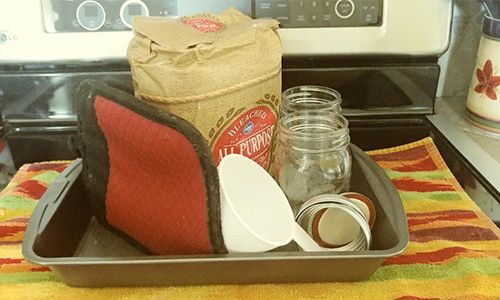
The supply list is a simple one, with many of the items probably already on hand. Take a look:
- Flour
- Canning jars and lids
- Funnel
- Clean paper towel to wipe the jar rims
- Oven mitts or towel
- Marker to date the jars.
You can do this method with any size bag or bags of flour as you want. The size of jars needs to make sense to your particular needs. If you go through a lot of flour, then larger jars would be best. However, if you don’t use it that often but came across a good sale on flour, then smaller jars would work.
For this particular project, I am using small jars, and not as much flour as I normally would work with, due to a shortage of flour in our area at this current time. All the more reason to buy in bulk and can it when the opportunity comes up!
Instructions
This process is so simple, you will wonder why you haven’t done this before now! Before beginning, make sure to sterilize the jars and lids, and thoroughly dry them before adding the flour. Any moisture in the jars or lids at all, and you could ruin the batch.
Preheat the oven to 215° Fahrenheit. Fill each sterilized jar, using the funnel, to the rim.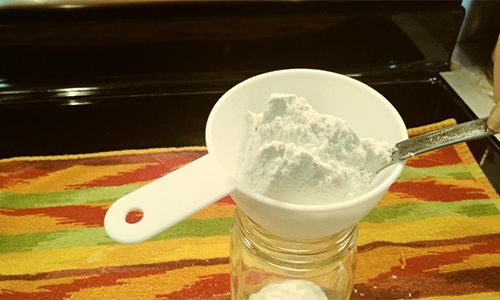 Tap down the jars to settle the flour so you can get more in each one. Fill it to the rim again. Repeat this step until you are sure the flour is settled down as much as it will go.
Tap down the jars to settle the flour so you can get more in each one. Fill it to the rim again. Repeat this step until you are sure the flour is settled down as much as it will go.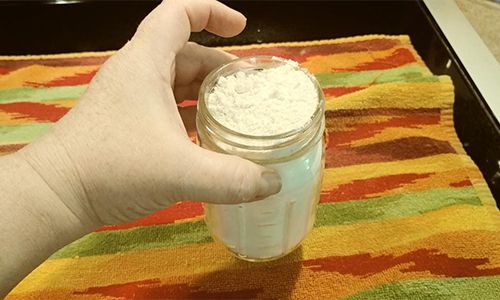 Place the filled jars on a baking tray or pan so they don’t tip, then place in the oven WITHOUT lids. Heat for 90-120 minutes.
Place the filled jars on a baking tray or pan so they don’t tip, then place in the oven WITHOUT lids. Heat for 90-120 minutes.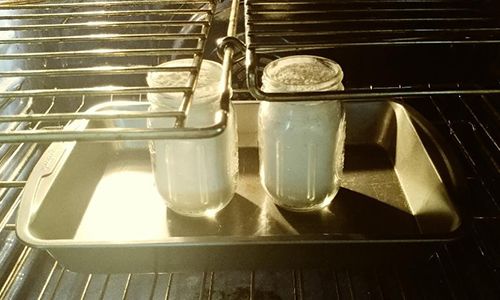 Once time is up, carefully remove each jar from the oven, one at a time. With a paper towel, wipe just the rim, so there isn’t any flour residue that could prevent a good seal.
Once time is up, carefully remove each jar from the oven, one at a time. With a paper towel, wipe just the rim, so there isn’t any flour residue that could prevent a good seal.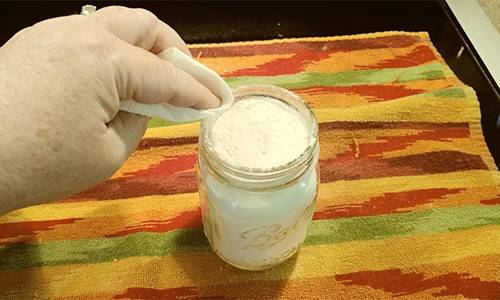 Place the lid on and tight it. Leave them out on the counter for several hours or overnight to cool completely, and the lids should seal.
Place the lid on and tight it. Leave them out on the counter for several hours or overnight to cool completely, and the lids should seal.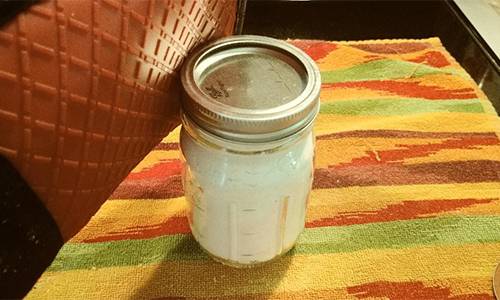 Let it cool before placing in a cool and dark storage space. Once they are cooled, you can also use a marker to write down the date you canned this batch. This will help to know when the shelf life is nearing its end.
Let it cool before placing in a cool and dark storage space. Once they are cooled, you can also use a marker to write down the date you canned this batch. This will help to know when the shelf life is nearing its end.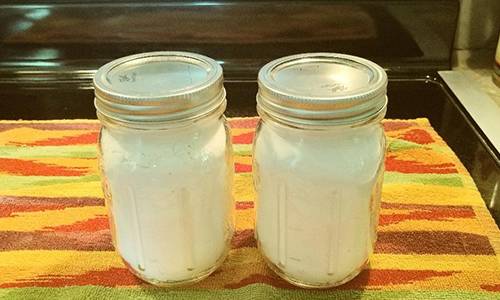 And, that is it! You can safely keep your abundance of flour for a few years, without taking up so much bulky space that airtight containers can bring.
And, that is it! You can safely keep your abundance of flour for a few years, without taking up so much bulky space that airtight containers can bring.
You may also like:
 Sealed Foods that Last Forever
Sealed Foods that Last Forever
This Homemade Device Can Power Up Your Entire House 7 Days in a Row (Video)
7 Deadly Canning Mistakes Even Smart People Make

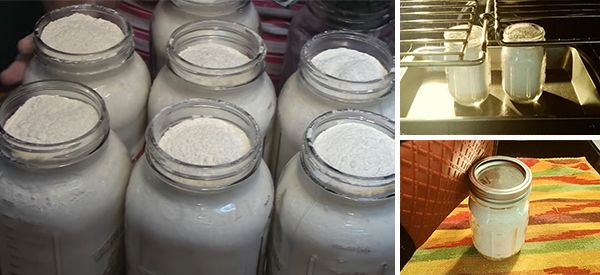













I discovered why my biscuits aren’t what they have been for 40 years. Soft wheat is required for good baking and White Lily is the answer not sold in the north states.
Only sold in the south, I bought 5 bags @ walmart before they mandated masks yesterday.
In freezer now, but I will use this method using pint jars.
thanks for extra space in freezer.
Jay.
Unbleached or Bleached Flour?
Your choice.
I have a manual grinder and whole wheat, corn, quinoa ect. I can grind the quantity I need. The whole grains last years longer.
It says bleached and enriched on the package.
Made from 100% soft winter wheat.
I have a manual grinder and whole wheat, corn, quinoa ect. I can grind the quantity I need. The whole grains last years longer.
Sounds great … what brand manual grinder do you have .. wiuld live to ourchase one.
camp: A blender works. We use that to grind coffee, spices, cornmeal, rice flour, and so on. niio
Have you used any of the four after canning? I’ve canned all-purpose flour in the past. Nothing I baked with it would rise. No matter which leavener I used. Any ideas as to what went wrong?
Depends on a lot of factors and what it is you are trying to bake. Check the brand of all-purpose flour you chose. The higher the protein level, the better it will rise. I use King Arthur All-Purpose Flour or High Altitude Hungarian Flour but I am at 7,000 ft above sea level. I use King Arthur Bread Flour when I use my bread maker and it rises beautifully. Inexpensive all-purpose flour doesn’t rise all that well. To fix that in a bread recipe, use some wheat gluten… 1 tbsp for every two or three cups of flour if you are making bread. For cake, you can add baking soda and/or baking powder depending on the recipe. If you are using yeast, test to make sure the yeast is still alive. If you are over 6,000 feet, follow high altitude directions and add a tablespoon of water and a 1/4 extra cup of flour. Hope that helps.
you may have come across what you need without knowing it. what you want is the lower protein of pastry flour. you can also buy soft white wheat flour to get that lowered protein. soft white is grown extensively in the pacific northwest. you can buy the wheat berries and grind as needed. or you can buy the flour, whole grain or bran and germ removed.
Gold Medal flour in the west.
I may try vaccumn sealing but still put in the few bay leaves.
Can this same process be used on rice & beans??
Nothing can beat White Lily products for baking!
JayJay – what do masks have to do with your comment?
How long do you freeze the flour? Do you then strain out the bug if any are found or just put from freezer to jars?
Run it through a sifter if it is buggy
Wouldn’t using the vacuum sealer do the same thing? I use my jar attachment and vacuum seal lots of things in mason jars. Just wondering.
I’ve been vacuum sealing my flour for years and it works well
I destroyed a vacuum sealer using it to vacuum seal quart jars of flour! If you use a vacuum sealer, seal it in the bags first? Or it will destroy the sealer!!!!
I haven’t canned in years. You put your lids and rims in water to sterilize. How do you dry them to get rid of the moisture?
That is how I store mine. That way not taking a chance with the heat changing the flour.
The extrem temp in the oven…kills all if not 99.9 per cent of the bacteria/wevels/moisture….mold spors…exctra
We placed our flour in the deep freeze for 4 days.
Then put it in food grade buckets with tight lids.
Supposed to kill off any bugs.
Would this work with almond flour? I’m diabetic and don’t use wheat-based flours. I’m worried about the oven heat making the flour go rancid due to the nut content.
If you are diabetic, I don’t think that wheat is going to be your main concern when you are starving.
If type 1, then select your grave site as insulin won’t be available.
Type 2 – once you lose a lot of weight, your insulin resistance goes down.
Starvation will kill you quicker than a little higher blood sugar for a type 2.
CS: I ate a little, very little, gluten, and both ear drums blew out. So, yes, if gluten is a problem, you can have a wonderful, if painful send off with a full belly.
Diabetes can be controlled by avoiding carbs, but beans and lemon juice are a major used in Mexico by diabetics who can’t afford the insulin. Mesquite also works.
Add some bay leaves to your flour. But, the best way to store grain is raw and whole. It can last for decades that way and not go rancid.
Love this idea and going to try it. Seems like whenever I use my flour it’s “dead” and won’t rise. Putting this idea in my recipe book to share with my kids.
Hi, I am just wondering if this method will work with gluten free flour as well? My wife was diagnosed celiac many years ago, so regular flour is a big No No for her
Has she tried sourdough? As it was explained to me, it is fermented, lowers the glutein content. I’ll make my own if I can actually eat it without side effects.
Lisa: I tried that and no go. Rice makes good sourdough.a plus from that is rice wine vinegar and rice beer, two things needed in Asian cooking. We use koji, the fungus used to make soy sauce. We’re doing our second batch of it for soy (using pinto beans). the first one was a disaster using yeast. Koji acts like a super yeast, fast rising and it can overheat if not watched. niio
No gluten for us either, so we will have to experiment?
sammy: I’m a seriously bad on gluten. If you take 2 part gluten free flour and one part corn starch, you can make noodles cakes, pancakes, and so on. Add xanthan gum and guar gum you can make loaves of bread.
Cornflour is almost as inexpensive as wheat flour. You can buy rolled oats and put it thru a blender. Bean flour, pintos and so on, were bred centuries ago for flour, to mix with cornflour. Beans grind to a fine flour in a blender, rice more coarse. Cornmeal is easy if you have a grinder. It costs about 5 dollar/bushel (60 lbs) at feed stores.
My intolerance is bad enough I can’t eat rye or barley. The VA claims I’m a diabetic, but as long as I stay away from gluten, there’s no sign of it. If you have Asian markets around, you can buy rice noodles, crackers, and starch noodles cheaply. the grandkids get the giggles over ‘invisible’ spaghetti 🙂 All they are is pure starch. If you can find pure tapioca, that should be fine, but it has to made with tapioca starch! Cana lily is called achira and the plant was domesticated for the roots, which are the second best starch in the world. American Indians peels and dried the roots (thin slices), then ground them to use as is or mixed wit other flours. Cana grows wild in Zone 8 and warmer areas. One rancher alone in Brazil plants thousands of acres each year. It’s a major commercial crop in Australia and Asia. niio
I dry pack lots of things, like fruit leather, crackers, dried fruit, etc. I think it would work well for any of your flours, including gluten free. I put them in the clean jars, wipe the rim, put the lid and ring on loosely, and put them in a cold oven. Turn the oven to 225 degrees for 45 minutes. When the time is up, immediately take them out of the oven and tighten the ring. I know the crackers last about 10-12 years, I am not sure on the rest.
Will it work with both all purpose and self rising flour?
This will free up freezer space for the beef this fall. Thanks
What about vacuum sealing? any special process for doing that and thoughts on shelf life?
I was thinking about using canning jars and O2 absorbers, would that work instead of heating the jars?
I can vouch for the this procedure. My family has been using it for about 15 to 20 years. Unfortunately if you try to extend the canned flour to 10 years you will see a significant decline in the nutritional value. There is an apparent degrading of the carbohydrates. It looks ok, but bread won’t rise. Seems to be a break down in the sugars that of course feed the yeast, which makes the bubbly…that’s the part is won’t do. If you are not willing to limit dry canning at 3 to 5, then stay with wheat berries and grind later.
I put grains or flour in jars. Lay bay leaves in top and bottom of the jar and close. It keeps for several years without bugs and stays good quality it not kept in a room above 70°. Heat isn’t good for long-term storage. It will get rancid and taste old.
Does the flavor of the bay leaves affect the flavor of the flour? Bay leaves have a very strong flavor.
Dawn: It takes heat and moisture to bring out the flavor of bay leaves. So, use as many as you like. niio
Thanks! That’s good to know.
We don’t eat wheat, barley, or rye, but some oats-, rice- and cornflour. rice is fermented for noodles and pancakes (sourdough), cornflour is resistant to bugs because it’s processed with lye/wood ashes for hominy. Oatmeal and oats seem to last quite a while on the shelf for us. when grain is used, usually only the amount needed is ground. any leftover flour is in ty freezer, and there isn’t a lot. Shell corn is frozen for a few days, then in steel barrels with bay leaves off the tree (Arizona Zone 9, bay laurel does well here). shell corn is a dime a pound, but buy cornmeal, it’s 2/lb. Yes, I am cheap. just ask the kids 🙂 niio
You’re not cheap, you’re thrifty! ?
Miz Kitty: Cheap but not easy 😉 niio!
How does one sterilize the lids in the above article’s process?? I would use boiling water and completely dry on a paper towel before using lids, and handle with sterlized tongs??
The only problem, with this, is that it kills the natural yeast, in the flour, rendering it useless for sourdough, without adding yeast.
Wolf: I live in Arizona. Anything you use will ferment even here. Yogurt works is you want to try that. We ferment grain for vinegar, beer, and rice wine as well as the sourdough. Koji yeast is good if you don’t mind buying it. There’s plenty of yeast all around. What I do not like about grain is it can have ergot or other molds on it that will kill you or damage nerves. niio
Will this method work for bread flour?
I have found that flour stored for a few years doesn’t rise as well for baking bread.
No gluten for us either, so we will have to experiment?
You don’t mention if you heat your seals and rings in boiling water before you put them on your jars of flour. Do you or don’t you? Thanks!
I’m needing to know about dry canning at altitude. We’re almost a mile high out here in the desert of AZ. I always have to adjust for water & pressure canning, but don’t see anything for this.
Also, how about for baking mixes like Bisquick, etc.? Will it work for something with baking soda?
to mountainman: sometime back I read and watch a video about “canning flour” – very interesting. so, in this video she had same problem – was using vacuum sealer w/jar attachment – kept getting flour in it – so she got “lunch bags”, measured out her flour, then folded the bag and put it into the jar and then sealed – voila! – no flour in the sealer stuff!!! have tried it myself, it works, little more work, but worth it. another one mentioned using a piece of waxed paper cut to fit, cheese cloth doubled and cut to fit. hope it helps